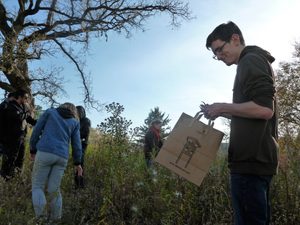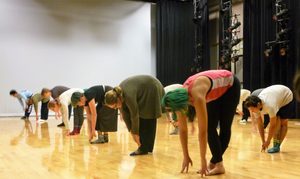
In late October, when most Minnesotans are dreaming of better weather, an outgoing troupe of Hawaiian dancers left their warm island homes to visit Carleton College. The group was greeted at the airport by Religion Professor Kristin Bloomer, who hosted them during their five-day residency in Minnesota.
During their stay, members of the Hula group were invited to speak in Professor Bloomer’s religion course, The Sacred Body. In this course, students explored cultural, political, and religious conversations around the human body. One of the overall themes of the course was how bodies can express religious and cultural messages through dance.

In preparation for their guests, students read extensively about the subtleties of Hula dancing as well as Hawaiian history and culture. Students learned that a Hula group was called a Hālau, and that the visiting group was named Hālau Kiawekūpono O Ka Ua (A Good Streak of Rain) because they believe people thrive when they connect to their source of water. While students learned what they could from journals and books, they had prepared lists of questions that only the Hālau could answer.

On October 25, Professor Bloomer’s classroom was packed with students eager to meet the Hālau; many students stated that this was the first time they had met a Hula dancer in person. Like many first encounters, the ice had to be broken. The leader of the Hālau, Kumu Dietrix Jon Ulukoa Duhaylonsod, affectionately called Kumu (teacher) by his troupe, began the introductions.

In a scene familiar to every social circle, each person in the room stated their name and purpose for being there, and a common connection among this group of students and dancers was their appreciation and reverence for spiritual expression. Another connection, made by Kumu, was that everyone in the room was there to learn from each other. For the next hour, the conversation flowed quickly, with Carleton students thoughtfully asking questions and the Hālau answering with generosity.
That afternoon, the Hālau and students, this time from a variety of classes, received a tour of the Carleton Arboretum, led by Nancy Braker, naturalist and Director of the Cowling Arboretum. While Nancy explained the natural flora of Minnesota’s prairies, the Hālau explained how natural materials are used to make traditional leis, and that a great deal of care is given to the creation of leis for special occasions in Hawaiian culture.

Throughout their arb tour, students paired with members of the Hālau to gather leaves, stems, flowers, and vines to make their own Carleton leis later on. As the sun began to set, everyone took a short break before regrouping at Professor Bloomer’s home for dinner and lei-making. Festivities ran late into the night, but the troupe rose early the next day, prepared to perform at the American Indian Center in Minneapolis.
The Hālau’s visit to the American Indian Center drew a diverse crowd of students and community members curious about Hula traditions. Before sharing an exclusive performance with attendees, the Hālau opened the door for conversation and cultural exchange with indigenous peoples of Minnesota, affirming a mutual respect for uplifting Native stories in a time where diverse voices are often overlooked by popular culture.
That night’s performance was called Mni Ki Wakan: Water is Sacred, which once again explored the philosophy that a connection to water is essential for people to thrive. This topic is particularly salient among indigenous communities in Minnesota, a state whose very name comes from the Siouxan word for water and whose communities were built around natural water sources. After a full day in the Twin Cities, the Hālau returned to Northfield for their next event: teaching a master Hula class for the Carleton community.
On the last leg of their journey, the Hālau extended an open invitation to anyone at Carleton interested in learning the basic moves and symbols of Hula dancing. Students from Professor Bloomer’s religion course were joined by a wide variety of learners, diverse in ages, disciplines, and backgrounds. The master class expounded on the spiritual and cultural significance of certain dance moves, and incorporated natural materials gathered from the Arb by students and the Hālau.
By the end of the two-hour session, attendees were able to perform a very short but intense, Hula dance following this Hālau’s particular style of dancing. Although it is impossible to condense hundreds of years of dancing tradition into a two-hour beginner course, this brief introduction to Hula helped spark curiosity and appreciation in people who had never before been exposed to this practice.
The Hālau’s visit concluded with a public Hula performance, open to the Carleton community and beyond. Guests from around Northfield were invited to experience the traditional music and dance representing Hawaiian culture. Audience reception of the performance was overwhelmingly positive, and local Northfielders had the chance to meet the dancers afterwards, expanding the connection between our two communities.
